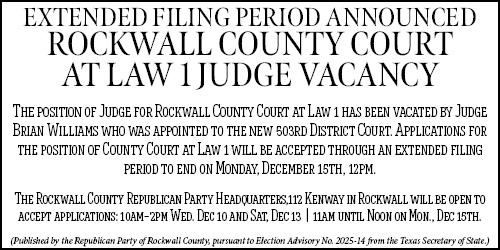
(Rockwall) August 28, 2013 – Ever spend the day running around, jumping through hoops and going in circles – only to find yourself back where you started?
 Sometimes all you need is a different perspective – a new way of looking at things.
Sometimes all you need is a different perspective – a new way of looking at things.
Rockwall HeartChase is an urban adventure that brings friends and co-workers together to collect clues, solve puzzles and complete checkpoints in the quickest time possible.
Presented by the American Heart Association, the community-wide challenge combines the spirit of The Amazing Race with wacky team-based games like Minute-to-Win-It. Throw in a little friendly competition and one very important mission, and the result is a whole bunch of zany fun with a purpose.
 Texas Health Presbyterian Hospital Rockwall and Lake Pointe Medical Center are platinum sponsors for the event. The adventure will begin at 4 p.m. Saturday, September 7th at The Harbor. Teams may be asked to build a literal food pyramid, learn a quick exercise routine, or find things of interest in the community that they never knew existed. Throughout the journey, participants will learn new ways to live a healthier lifestyle.
Texas Health Presbyterian Hospital Rockwall and Lake Pointe Medical Center are platinum sponsors for the event. The adventure will begin at 4 p.m. Saturday, September 7th at The Harbor. Teams may be asked to build a literal food pyramid, learn a quick exercise routine, or find things of interest in the community that they never knew existed. Throughout the journey, participants will learn new ways to live a healthier lifestyle.
 The team that accumulates the most points will be declared the HeartChase Champion. Points will be earned by successfully completing the checkpoints, by pre-event and text-to-give fundraising, and by locating and texting in clues throughout the journey. Periodic text updates will keep teams informed about who’s in the lead, what their current point totals are, and how much time is left in the Chase – plus a few healthy tips along the way.
The team that accumulates the most points will be declared the HeartChase Champion. Points will be earned by successfully completing the checkpoints, by pre-event and text-to-give fundraising, and by locating and texting in clues throughout the journey. Periodic text updates will keep teams informed about who’s in the lead, what their current point totals are, and how much time is left in the Chase – plus a few healthy tips along the way.
 The American Heart Association reports that cardiovascular disease and stroke are the nation’s No. 1 and No. 3 killers – and these risks can be reduced or even eliminated with healthy lifestyle habits and exercise. To get involved, community members may form or join an existing HeartChase team, or become an event sponsor or volunteer.
The American Heart Association reports that cardiovascular disease and stroke are the nation’s No. 1 and No. 3 killers – and these risks can be reduced or even eliminated with healthy lifestyle habits and exercise. To get involved, community members may form or join an existing HeartChase team, or become an event sponsor or volunteer.
Follow Rockwall HeartChase on Facebook at facebook.com/heartchaserockwall.
By Dawn Redig, Blue Ribbon News, all rights reserved.
If you liked this story, please click here to LIKE our Facebook page, so we can reach more people with good news like this! To share your good news and events, email editor@BlueRibbonNews.com.
RELATED STORY
Costs to treat heart failure expected to more than double by 2030
By 2030, you — and every U.S.taxpayer — could be paying $244 a year to care for heart failure patients, according to an American Heart Association policy statement. The statement, published online in the American Heart Association journal Circulation: Heart Failure, predicts:
- The number of people with heart failure could climb 46 percent from 5 million in 2012 to 8 million in 2030.
- Direct and indirect costs to treat heart failure could more than double from $31 billion in 2012 to $70 billion in 2030.
“If we don’t improve or reduce the incidence of heart failure by preventing and treating the underlying conditions, there will be a large monetary and health burden on the country,” said Paul A. Heidenreich, M.D., M.S., professor of medicine at Stanford University School of Medicine and director of the Chronic Heart Failure Quality Enhancement Research Initiative at the VA Health Care System in Palo Alto, Calif. “The costs will be paid for by every adult in this country, not just every adult with heart failure.”
The rising incidence is fueled by the aging population and an increase in the number of people with conditions like ischemic heart disease, hypertension and diabetes — contributors to the development of heart failure. Being older, a smoker, a minority or poor are also risk factors.
“Awareness of risk factors and adequately treating them is the greatest need,” Heidenreich said.
Heart failure is a life-threatening condition that occurs when the heart has been weakened from heart disease, high blood pressure, diabetes and other underlying conditions, and can no longer pump enough oxygen- and nutrient-rich blood throughout the body.
Heart failure is the leading cause of hospitalization for Americans over age 65. Patients are often fatigued and have breathing problems, as the heart enlarges and pumps faster to try to meet the body’s needs.
“Heart failure is a disease of the elderly,” Heidenreich said. “Because our population is aging, it will become more common and the cost to treat heart failure will become a significant burden to theUnited Statesover the next 20 years unless something is done to reduce the age-specific incidence.”
The statement includes recommendations on lessening the impact of heart failure and managing the rising number of Americans with the condition. These include:
- More effective dissemination and use of guideline-recommended therapy to prevent heart failure and improve survival.
- Improving the coordination of care from hospital to home to achieve better outcomes and reduce rehospitalizations.
- Specialized training for physicians, nurses, pharmacists and other healthcare professionals to meet the future demands of advanced heart failure care.
- Reducing disparities for heart failure prevention and care among racial, ethnic, and socioeconomic subgroups to help close the gap in health outcomes.
- Increasing access to palliative and hospice care, for patients with advanced-stage heart failure.
“We have the solutions we need to change the course of heart failure in this country, but we must take steps now to reverse the trend,” said American Heart Association CEO Nancy Brown. “If we treat patients using existing guidelines, improve care transitions, adequately train our healthcare workforce and reduce disparities in the health outcomes of specific populations, we can lessen the burdens of heart failure.”
“For those Americans in the last stages of heart failure, we must also increase access to palliative and hospice care to reduce the suffering of their final years.”
The statement doesn’t examine the impact of provisions of the Affordable Care Act. If laws allow more people to have access to health care, it could lower the rates of heart failure and ultimately costs as people will have access to preventive care, Heidenreich said.
Also, being an ethnic minority and of a lower socio-economic status were both cited as risk factors for heart failure, so more access to health care may help reduce overall risk.
Submitted by Shelly Millwee, American Heart Association.





